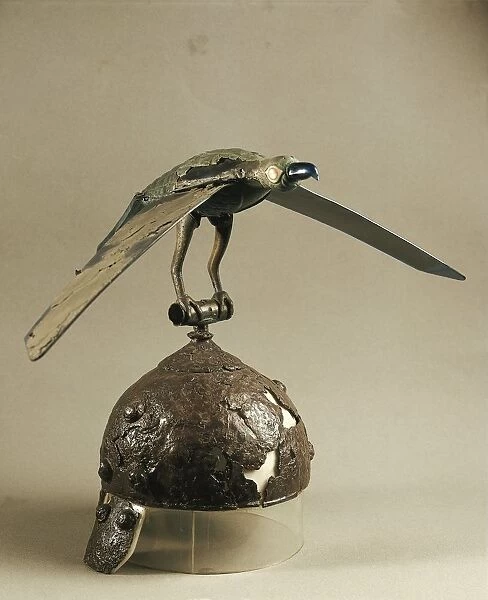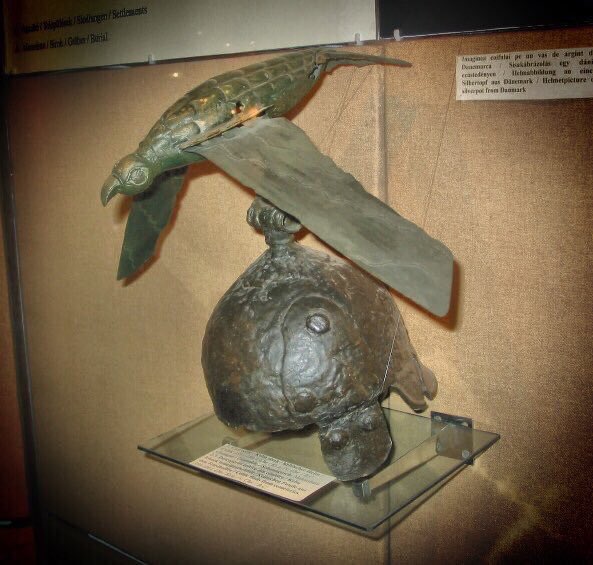Introduction
Nestled in the rolling hills of Satu Mare, Romania, a remarkable archaeological discovery has captivated the attention of historians, archaeologists, and art enthusiasts alike. The Ciumești helmet, an exquisite relic from the Iron Age Celtic era, has stood as a testament to the ingenuity and cultural richness of the ancient inhabitants of this region, once known as northern Dacia.

Discovered in 1961 within a regal burial site, this remarkable helmet, dating back to the 4th century BC, has become a symbol of the enduring legacy of the Celts. Adorned with a striking raven totem, the Ciumești helmet not only serves as a stunning piece of ancient craftsmanship but also offers a glimpse into the intricate beliefs and rituals of this captivating civilization.
In this blog post, we will delve into the captivating history and significance of the Ciumești helmet, exploring its origins, symbolism, and the insights it provides into the lives and customs of the Iron Age Celts.
The Discovery of the Ciumești Helmet
In the year 1961, a remarkable archaeological discovery was made in the small village of Ciumești, located in the Satu Mare region of Romania. During an excavation at a regal burial site, a team of archaeologists stumbled upon a remarkable artifact – the Ciumești helmet.
The helmet, crafted from bronze and adorned with a stunning raven totem, was found alongside a wealth of other artifacts, including jewelry, weapons, and various ceremonial objects. The burial site itself was a testament to the importance and status of the individual interred there, suggesting that this was the final resting place of a prominent figure within the Celtic community.
The Ciumești helmet, with its intricate design and well-preserved condition, immediately captured the attention of the archaeological community. Its discovery not only provided valuable insights into the material culture of the ancient Celts but also shed light on their beliefs, rituals, and societal structures.
The Significance of the Raven Totem
One of the most striking features of the Ciumești helmet is the presence of a raven totem adorning its surface. The raven, a powerful and revered symbol in Celtic mythology, held a special significance for the ancient inhabitants of this region.
In Celtic belief systems, the raven was often associated with the god Lugh, a multifaceted deity who was believed to possess a wide range of abilities, including divination, healing, and warfare. The raven was seen as a messenger of the gods, a harbinger of both good and bad tidings, and a symbol of wisdom and foresight.
The inclusion of the raven totem on the Ciumești helmet suggests that the individual interred with this artifact held a position of great importance and authority within the Celtic community. The raven, with its association with the divine and the realm of the supernatural, likely imbued the wearer of the helmet with a sense of spiritual power and connection to the divine.
Furthermore, the flapping wings of the raven totem, which are activated when the helmet is in motion, add an element of dynamism and movement to the artifact. This feature not only enhances the visual appeal of the helmet but also suggests that it may have been used in ceremonial or ritual contexts, where the fluttering wings could have been seen as a manifestation of the raven’s supernatural abilities.
The Craftsmanship and Artistry of the Ciumești Helmet
The Ciumești helmet is a true masterpiece of ancient Celtic metalworking and artistry. Crafted from bronze, the helmet features a distinctive shape that is characteristic of Iron Age Celtic helmets, with a rounded dome and a prominent brow ridge.
The attention to detail and the level of craftsmanship displayed in the creation of the Ciumești helmet are truly remarkable. The raven totem, which adorns the front of the helmet, is a testament to the skill and artistry of the Celtic metalworkers who created this artifact.
![Celtic helmet with a complete winged-bird crest from the 3rd century BCE, found at Ciumesti, Romania. [800x731] : r/ArtefactPorn](https://preview.redd.it/9itwlbco80d31.jpg?auto=webp&s=b5de4bf7b3e34399b4683f2667ce64f7fdc6df2b)
The raven’s features, including its beak, eyes, and feathers, are rendered with exceptional precision and realism. The wings of the raven, which are hinged and able to flap when the helmet is in motion, add an element of dynamism and movement to the piece, further enhancing its visual appeal and ceremonial significance.
In addition to the raven totem, the Ciumești helmet also features intricate patterns and designs that are characteristic of Celtic art. These decorative elements, which include geometric motifs and stylized representations of natural forms, demonstrate the Celts’ deep appreciation for the beauty and symbolism of the natural world.
The level of detail and the technical mastery evident in the Ciumești helmet suggest that it was likely created by a highly skilled and specialized metalworker, perhaps even a member of a specialized guild or workshop. This level of craftsmanship not only speaks to the artistic prowess of the Celts but also highlights the importance and value placed on the creation of ceremonial and ritual objects within their society.
The Ceremonial and Ritual Significance of the Ciumești Helmet
The Ciumești helmet, with its striking raven totem and flapping wings, was most likely used for ceremonial and ritual purposes within the Celtic community. The helmet’s association with the god Lugh and the raven’s symbolic connection to the divine realm suggest that it was imbued with a deep spiritual significance.
It is possible that the Ciumești helmet was worn by a prominent religious or political figure within the Celtic society, such as a priest, chieftain, or warrior-king. The helmet’s presence within a regal burial site further supports this hypothesis, as it suggests that the individual interred there held a position of great importance and authority within the community.
The flapping wings of the raven totem, which are activated when the helmet is in motion, may have been a central feature of the helmet’s ceremonial use. This dynamic element could have been seen as a manifestation of the raven’s supernatural powers, and the wearer of the helmet may have been perceived as a conduit between the mortal and divine realms.
In addition to its ceremonial use, the Ciumești helmet may have also served as a symbol of power and status within the Celtic community. The intricate craftsmanship and the use of precious materials, such as bronze, would have made this helmet a highly valuable and prestigious object. The individual who wore this helmet would have been instantly recognized as a figure of great importance and authority, further reinforcing the helmet’s ceremonial and ritual significance.
The Cultural Context of the Ciumești Helmet
The Ciumești helmet, with its striking raven totem and flapping wings, provides valuable insights into the cultural and societal structures of the ancient Celts who inhabited the region of northern Dacia (modern-day Romania).
During the Iron Age, the Celts were a widespread and influential civilization that stretched across much of Europe, from the British Isles to the Iberian Peninsula and beyond. The Celts were known for their rich cultural traditions, including their language, art, and religious beliefs, which were deeply rooted in the natural world and the supernatural realm.

The discovery of the Ciumești helmet in a regal burial site suggests that the individual interred there was a prominent figure within the Celtic community, perhaps a religious leader, warrior-king, or member of the aristocratic elite. The presence of the raven totem and the helmet’s ceremonial significance indicate that the Celts placed great importance on the spiritual and ritual aspects of their culture.
Furthermore, the high level of craftsmanship and the use of precious materials, such as bronze, demonstrate the Celts’ advanced metalworking skills and the value they placed on the creation of ceremonial and ritual objects. This, in turn, provides insights into the economic and social structures of the Celtic society, where specialized artisans and craftspeople likely held important positions within the community.
The Ciumești helmet, with its captivating design and rich cultural context, serves as a powerful reminder of the enduring legacy of the ancient Celts. This remarkable artifact not only offers a glimpse into the beliefs and customs of this fascinating civilization but also inspires us to continue exploring and preserving the cultural heritage of the past.
Conclusion
The Ciumești helmet, a stunning relic from the Iron Age Celtic era, has captivated the hearts and minds of historians, archaeologists, and art enthusiasts alike. Discovered in a regal burial site in northern Dacia (modern-day Romania), this remarkable artifact, dating back to the 4th century BC, stands as a testament to the ingenuity, artistry, and cultural richness of the ancient Celts.
Adorned with a striking raven totem, the Ciumești helmet not only serves as a stunning piece of metalworking but also offers a glimpse into the intricate beliefs and rituals of this captivating civilization. The raven, a powerful symbol in Celtic mythology, imbued the wearer of the helmet with a sense of spiritual power and connection to the divine realm.
The exceptional craftsmanship and attention to detail displayed in the creation of the Ciumești helmet are a true testament to the skill and artistry of the Celtic metalworkers. The flapping wings of the raven totem, a dynamic feature that adds to the helmet’s ceremonial significance, further enhances the visual appeal and symbolic meaning of this remarkable artifact.
As we delve deeper into the history and cultural context of the Ciumești helmet, we are reminded of the enduring legacy of the ancient Celts. This remarkable artifact not only serves as a window into the past but also inspires us to continue exploring and preserving the rich cultural heritage of this fascinating civilization.

